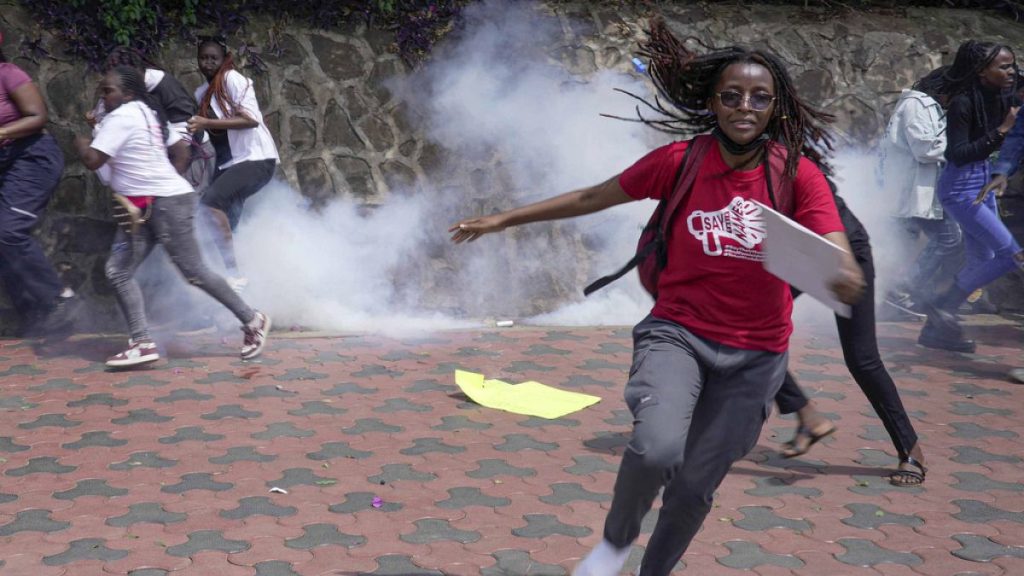The streets of Nairobi, Kenya, recently became a battleground as police clashed with protesters rallying against the escalating scourge of gender-based violence. Under the poignant banner of “Stop Feminicide,” demonstrators voiced their outrage at the alarming rise in violence against women, a crisis tragically highlighted by the reported deaths of 97 women. The protest, however, met with a forceful response from law enforcement, who deployed tear gas to scatter the crowds, adding another layer of complexity to the already fraught issue of gender inequality and violence in the country. The incident underscores not only the urgent need for greater protection and justice for women but also the challenges faced by those seeking to raise their voices against these injustices. The use of force against peaceful protesters further raises concerns about freedom of expression and the government’s response to dissent.
The backdrop to this confrontation is a deeply rooted societal problem. Gender-based violence, encompassing physical, sexual, and emotional abuse, has long plagued Kenyan society, impacting countless women and girls across the country. The reported statistic of 97 women killed represents a horrifying peak in this ongoing crisis, signaling a worrying trend of increased violence and a desperate need for effective intervention. While the exact circumstances surrounding these deaths require further investigation, the sheer number underscores the vulnerability of women and the urgent imperative for societal reform to challenge the patriarchal norms that perpetuate such violence. This grim reality highlights the systemic nature of gender-based violence, extending beyond individual incidents to represent a widespread societal failure to protect and empower women.
The protesters’ cry of “Stop Feminicide” encapsulates the core demand for an end to the killing of women simply because of their gender. Feminicide, the intentional killing of women because they are women, represents the extreme end of the spectrum of gender-based violence, highlighting the deep-seated misogyny and discrimination that fuels such acts. The protesters’ adoption of this term reflects a growing recognition of the specific and targeted nature of violence against women and a demand for its recognition as a distinct and serious crime. The use of “feminicide” also emphasizes the need for a specific legal framework and targeted interventions to address this particular form of violence, going beyond general laws against violence and homicide.
The police response to the protest, using tear gas to disperse the crowds, raises critical questions about the government’s approach to addressing gender-based violence and its commitment to protecting the rights of its citizens to peaceful assembly and protest. While maintaining order is a legitimate concern, the use of force against individuals demonstrating against a critical social issue such as violence against women can be interpreted as a silencing tactic and a disregard for the very concerns the protesters are raising. This response can also have a chilling effect on future protests and activism, potentially hindering efforts to bring about meaningful change. The incident necessitates a deeper examination of the relationship between the government, law enforcement, and citizens’ right to protest, particularly in the context of sensitive social issues.
Beyond the immediate confrontation in Nairobi, this incident serves as a microcosm of the broader challenges facing women in Kenya and many other parts of the world. The struggle for gender equality and an end to violence against women requires sustained efforts on multiple fronts, encompassing legal reforms, educational initiatives, and societal shifts in attitudes and behaviors. The legal system must provide effective mechanisms for reporting and prosecuting gender-based violence, ensuring that perpetrators are held accountable and survivors receive appropriate support and protection. Education plays a crucial role in challenging harmful gender stereotypes and promoting respectful relationships. Ultimately, lasting change requires a fundamental shift in societal norms and attitudes, fostering a culture of respect for women and a rejection of all forms of violence against them.
The incident in Nairobi serves as a stark reminder of the ongoing fight for women’s rights and the urgent need for collective action. The voices of those protesting against gender-based violence must be heard and amplified, not silenced with force. The tragic loss of 97 women demands not only justice but also a comprehensive and sustained commitment to addressing the root causes of violence against women. This includes challenging patriarchal norms, promoting gender equality, and empowering women to live free from fear and violence. The path forward requires the concerted efforts of governments, civil society organizations, communities, and individuals to create a society where women are safe, respected, and valued as equal members. The protest, although met with resistance, represents a vital step in this ongoing journey, highlighting the unwavering determination of those fighting for a better future for all.














